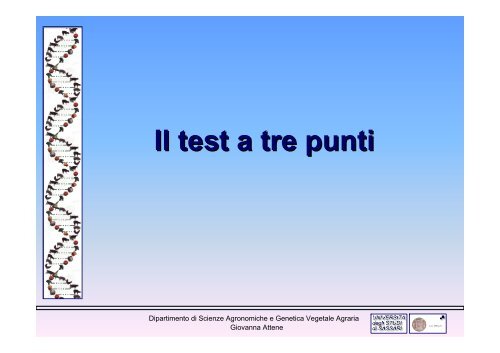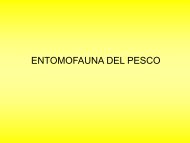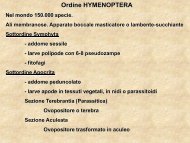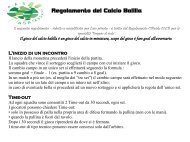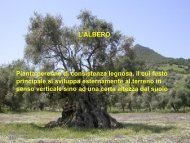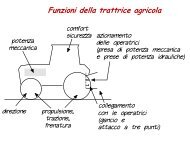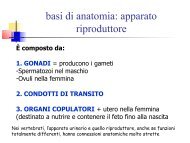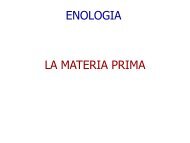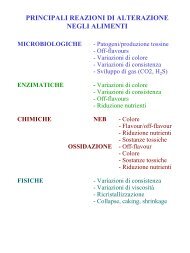13. Il test a tre punti - Associazione Studenti di Agraria IAAS Sassari
13. Il test a tre punti - Associazione Studenti di Agraria IAAS Sassari
13. Il test a tre punti - Associazione Studenti di Agraria IAAS Sassari
You also want an ePaper? Increase the reach of your titles
YUMPU automatically turns print PDFs into web optimized ePapers that Google loves.
<strong>Il</strong> <strong>test</strong> a <strong>tre</strong> <strong>punti</strong><br />
Dipartimento <strong>di</strong> Scienze Agronomiche e Genetica Vegetale <strong>Agraria</strong><br />
Giovanna Attene
Ricombinazione tra geni associati<br />
La frequenza <strong>di</strong><br />
ricombinazione tra due loci<br />
<strong>di</strong>pende dalla frequenza <strong>di</strong><br />
crossing over<br />
La frequenza <strong>di</strong> crossing<br />
over fra due loci è funzione<br />
della loro <strong>di</strong>stanza sul<br />
cromosoma (Morgan)<br />
La frequenza <strong>di</strong><br />
ricombinazione viene<br />
assunta come misura della<br />
<strong>di</strong>stanza dei geni sul<br />
cromosoma
Ricombinazione tra geni associati<br />
Crossing-over singolo tra il gene A ed il gene B<br />
Crossing-over doppio a due filamenti tra il gene A ed il gene B<br />
Parentale<br />
Ricombinante<br />
Ricombinante<br />
Parentale<br />
Parentale<br />
Parentale<br />
Parentale<br />
Parentale
Ricombinazione tra geni associati<br />
Due geni<br />
Crossing-over doppio a due filamenti tra il gene A ed il gene B<br />
Parentale<br />
Parentale<br />
Parentale<br />
Parentale<br />
Crossing-over doppio a <strong>tre</strong> filamenti tra il gene A ed il gene B<br />
Ricombinante<br />
Parentale<br />
Ricombinante<br />
Parentale<br />
Crossing-over doppio a <strong>tre</strong> filamenti tra il gene A ed il gene B<br />
Parentale<br />
Ricombinante<br />
Parentale<br />
Ricombinante<br />
Crossing-over doppio a quattro filamenti tra il gene A ed il gene B<br />
b<br />
b<br />
B<br />
B<br />
Ricombinante<br />
Ricombinante<br />
Ricombinante<br />
Ricombinante<br />
<strong>Il</strong> crossing-over è<br />
avvenuto ma non è<br />
osservabile.<br />
50% parentali<br />
50% ricombinanti
Crossing-over doppio a due filamenti e <strong>tre</strong> geni<br />
C<br />
c<br />
Crossing-over doppio a <strong>tre</strong> filamenti e <strong>tre</strong> geni<br />
C<br />
c<br />
Crossing-over doppio a <strong>tre</strong> filamenti e <strong>tre</strong> geni<br />
C<br />
c<br />
Crossing-over doppio a quattro filamenti e <strong>tre</strong> geni<br />
C<br />
c<br />
Ricombinazione tra geni associati<br />
C<br />
c<br />
C<br />
c<br />
C<br />
c<br />
C<br />
c<br />
C<br />
c<br />
C<br />
c<br />
C<br />
c<br />
C<br />
c<br />
Tre geni<br />
b<br />
b<br />
B<br />
B<br />
Tipo <strong>di</strong> gamete<br />
Non crossover<br />
Crossover doppio<br />
Crossover doppio<br />
Non crossover<br />
Crossover singolo<br />
Crossover doppio<br />
Crossover singolo<br />
Non crossover<br />
Non crossover<br />
Crossover singolo<br />
Crossover doppio<br />
Crossover singolo<br />
Crossover singolo<br />
Crossover singolo<br />
Crossover singolo<br />
Crossover singolo<br />
Tipo <strong>di</strong> gamete senza<br />
gene centrale (C)<br />
Parentale<br />
Parentale<br />
Parentale<br />
Parentale<br />
Ricombinante<br />
Parentale<br />
Ricombinante<br />
Parentale<br />
Parentale<br />
Ricombinante<br />
Parentale<br />
Ricombinante<br />
Ricombinante<br />
Ricombinante<br />
Ricombinante<br />
Ricombinante<br />
<strong>Il</strong> gene centrale<br />
consente una<br />
stima più<br />
precisa degli<br />
eventi <strong>di</strong><br />
ricombinazione<br />
tra A e B e<br />
quin<strong>di</strong> della<br />
loro <strong>di</strong>stanza <strong>di</strong><br />
mappa
IMPORTANTE:<br />
NEI CROSSOVER DOPPI I GENI ESTREMI NON MOSTRANO<br />
RICOMBINAZIONE<br />
SOLO IL GENE CENTRALE MOSTRA RICOMBINAZIONE<br />
IL CONFRONTO FRA I FENOTIPI DEI PARENTALI E QUELLI<br />
DEI CROSSOVER DOPPI CONSENTE DI STABILIRE LA<br />
POSIZIONE DEL GENE CENTRALE E DI CONSEGUENZA<br />
L’ORDINE DEI GENI SUL CROMOSOMA<br />
(ATTENZIONE: I FENOTIPI DELLA PROGENIE DEL REINCROCIO<br />
CORRISPONDONO AGLI APLOTIPI DEI GAMETI DEL TRIIBRIDO!!)<br />
INSIEME DELLE FORME ALLELICHE PRESENTI IN UN GAMETE
Ricombinazione tra geni associati<br />
Mappatura genica: <strong>Il</strong> <strong>test</strong> a <strong>tre</strong> <strong>punti</strong><br />
Reincrocio (BC1)<br />
ShshCcWxwx X shshccwxwx<br />
Gameti Fenotipo N. cariossi<strong>di</strong> %<br />
Sh C wx pieno, colorato, ceroso 4455 9.72<br />
sh C wx collassato, colorato, ceroso 509 1.11<br />
Sh c wx pieno, non colorato, ceroso 12 0.03<br />
sh c wx collassato, non colorato, ceroso 17699 38.62<br />
Sh C Wx pieno, colorato, normale 17959 39.18<br />
sh C Wx collassato, colorato, normale 20 0.04<br />
Sh c Wx pieno, non colorato, normale 524 1.14<br />
sh c Wx collassato, non colorato, normale 4654 10.15<br />
Totale 45832 100<br />
Con assortimento in<strong>di</strong>pendente 1:1:1:1:1:1:1:1
Quale è l’or<strong>di</strong>ne or<strong>di</strong>ne e la <strong>di</strong>stanza tra i geni sul cromosoma?<br />
cromosoma<br />
? ?<br />
C? Sh ? Wx ?<br />
Gameti Fenotipo N. cariossi<strong>di</strong> %<br />
Sh c wx pieno, non colorato, ceroso 12 0.03<br />
sh c wx collassato, non colorato, ceroso 17699 38.62<br />
Sh C Wx pieno, colorato, normale 17959 39.18<br />
sh C Wx collassato, colorato, normale 20 0.04
Quali sono i genotipi dei parentali del triibrido?<br />
CCShShWxWx X ccshshwxwx<br />
CcShshWxwx X ccshshwxwx<br />
Gameti Fenotipo N. cariossi<strong>di</strong> %<br />
c sh wx non colorato, collassato, ceroso 17699 38.62<br />
C Sh Wx colorato, pieno, normale 17959 39.18
Quale è la <strong>di</strong>stanza tra i geni sul cromosoma?<br />
C Sh Wx<br />
c sh wx<br />
Cromosomi<br />
parentali<br />
Tipi <strong>di</strong> crossing over Ricombinanti<br />
C Sh Wx<br />
c sh wx<br />
C Sh Wx<br />
c sh wx<br />
C Sh Wx<br />
c sh wx<br />
C sh wx<br />
c Sh Wx<br />
C Sh wx<br />
c sh Wx<br />
C sh Wx<br />
c Sh wx<br />
Ricombinanti della regione I<br />
C sh wx<br />
c Sh Wx<br />
C sh Wx<br />
c Sh wx<br />
509<br />
524<br />
20<br />
12<br />
1065<br />
Ricombinanti della regione II<br />
C Sh wx<br />
c sh Wx<br />
C sh Wx<br />
c Sh wx<br />
4455<br />
4654<br />
20<br />
12<br />
9141
Quale è la <strong>di</strong>stanza tra i geni sul cromosoma?<br />
? ?<br />
C? Sh ? Wx ?<br />
Ricombinanti della regione C-Sh<br />
C sh wx<br />
c Sh Wx<br />
C sh Wx<br />
c Sh wx<br />
509<br />
524<br />
20<br />
12<br />
Ricombinanti della regione Sh-Wx<br />
C Sh wx<br />
c sh Wx<br />
C sh Wx<br />
c Sh wx<br />
4455<br />
4654<br />
1065 / 45832 * 100<br />
9141 / 45832 * 100<br />
= 2.32% = 2.32 cM = 19.94% = 19.94 cM<br />
20<br />
12
Quale è la <strong>di</strong>stanza tra i geni sul cromosoma?<br />
C? Sh ? Wx ?<br />
Ricombinanti della regione C-Sh<br />
C sh wx<br />
c Sh Wx<br />
C sh Wx<br />
c Sh wx<br />
2.32 cM 19.94 cM<br />
509<br />
524<br />
20<br />
12<br />
?<br />
22.26 cM<br />
Ricombinanti della regione Sh-Wx<br />
C Sh wx<br />
c sh Wx<br />
C sh Wx<br />
c Sh wx<br />
4455<br />
4654<br />
1065 / 45832 * 100<br />
9141 / 45832 * 100<br />
= 2.32% = 2.32 cM = 19.94% = 19.94 cM<br />
20<br />
12
Senza considerare crossing over doppi:<br />
Ricombinanti della regione C-Sh Ricombinanti della regione Sh-Wx<br />
C sh wx<br />
c Sh Wx<br />
C sh Wx<br />
c Sh wx<br />
2.32 cM 19.94 cM<br />
1033<br />
2.25 cM 19.87 cM<br />
Sh<br />
C Wx<br />
509<br />
524<br />
20<br />
12<br />
22.26 cM<br />
22.12 cM<br />
C Sh wx<br />
c sh Wx<br />
C sh Wx<br />
c Sh wx<br />
4455<br />
4654<br />
1065 / 45832 * 100<br />
9109 9141 / 45832 * 100<br />
= 2.32% = 2.32 cM = 19.94% = 19.94 cM<br />
= 2.25% = 2.25 cM = 19.87% = 19.87 cM<br />
20<br />
12<br />
SOTTOSTIMA<br />
DISTANZE !!!
Grado <strong>di</strong> interferenza e coefficiente <strong>di</strong> coincidenza<br />
Nell’ipotesi che i due crossing over singoli siano due eventi<br />
in<strong>di</strong>pendenti la probabilità che questi avvengano<br />
contemporaneamente (= crossing over doppi attesi) è data dal<br />
prodotto delle probabilità dei crossing over singoli:<br />
Crossover<br />
doppi<br />
attesi<br />
Crossover<br />
doppi<br />
osservati<br />
Coefficiente <strong>di</strong><br />
coincidenza<br />
Grado <strong>di</strong><br />
interferenza<br />
Probabilità<br />
Probabilità<br />
= crossover C-Sh X crossover Sh-Wx = 0.46%<br />
2.32%<br />
19.94%<br />
= 0.07% ? Interferenza<br />
=<br />
Crossover doppi osservati<br />
Crossover doppi attesi<br />
= 100-15.22 = 84.78%<br />
= 0.07% /0.46% = 15.22%
Grazie ai <strong>test</strong> a due <strong>punti</strong> e a <strong>tre</strong> <strong>punti</strong> è possibile mappare i<br />
geni e stabilire il loro or<strong>di</strong>ne sul cromosoma<br />
<strong>Il</strong> calcolo delle <strong>di</strong>stanze tra i geni è alla base della costruzione<br />
delle mappe genetiche<br />
La mappa genetica è la rappresentazione grafica dei gruppi <strong>di</strong><br />
associazione <strong>di</strong> una specie con l’in<strong>di</strong>cazione dell’or<strong>di</strong>ne e della<br />
posizione relativa dei geni lungo il cromosoma<br />
I gruppi <strong>di</strong> associazione sono tanti quante sono le coppie <strong>di</strong><br />
cromosomi omologhi <strong>di</strong> una specie<br />
Le <strong>di</strong>stanze tra i geni nelle mappe genetiche sono misurate in<br />
cM (unità <strong>di</strong> ricombinazione, unità <strong>di</strong> mappa)
Ol<strong>tre</strong> alle mappe genetiche è ora possibile costruire le mappe<br />
fisiche, fisiche misurate in bp (coppie <strong>di</strong> basi)<br />
La relazione tra mappe genetiche e mappe fisiche spesso non<br />
è uniforme pur conservando i loci lo stesso or<strong>di</strong>ne tra le due<br />
mappe (colinearit colinearità)<br />
y<br />
w<br />
y<br />
w<br />
c c<br />
s<br />
Mappa genetica Mappa fisica<br />
s


